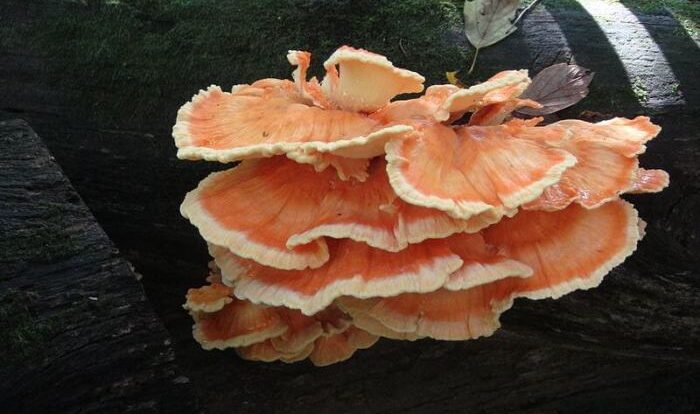
Chicken of the woods recipe – Chicken of the woods is a vibrant mushroom that boasts a delicious, meaty flavor. This culinary gem is not only a treat for the taste buds but also a treasure trove of nutritional benefits. Join us as we delve into the world of chicken of the woods, exploring its nutritional value, foraging techniques, and a variety of delectable recipes that will tantalize your palate.
With its striking orange hue and succulent texture, chicken of the woods has captured the attention of chefs and foragers alike. Whether you’re a seasoned mushroom enthusiast or a curious home cook, this guide will provide you with all the essential information you need to enjoy this extraordinary fungus.
Nutritional Value and Health Benefits: Chicken Of The Woods Recipe
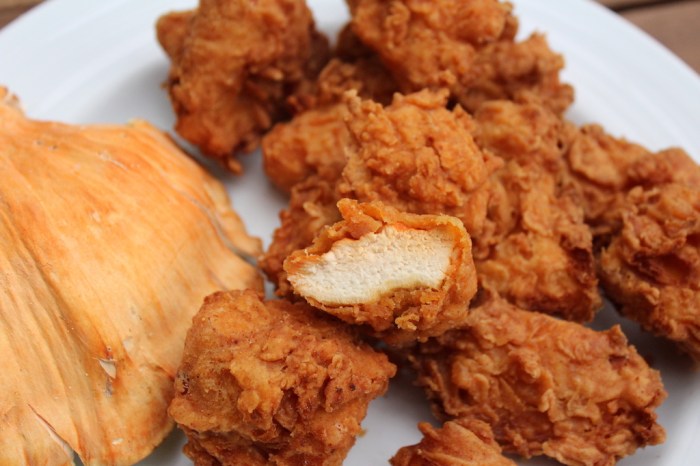
Chicken of the woods mushrooms boast an impressive nutritional profile, making them a valuable addition to a healthy diet.
They are low in calories and fat, while being rich in fiber, protein, vitamins, and minerals. Notably, they are a good source of vitamin D, which is essential for bone health and immune function.
Immune Support
Chicken of the woods mushrooms contain polysaccharides, such as beta-glucans, which have been shown to stimulate the immune system. They may help protect against infections and enhance overall immune response.
Antioxidant Properties
These mushrooms are rich in antioxidants, such as ergothioneine and glutathione, which help protect cells from damage caused by free radicals. Antioxidants are important for maintaining overall health and may reduce the risk of chronic diseases.
Potential Anti-Cancer Effects
Studies have suggested that chicken of the woods mushrooms may have anti-cancer properties. They contain compounds that have been shown to inhibit tumor growth and promote apoptosis (cell death) in cancer cells.
Foraging and Identification
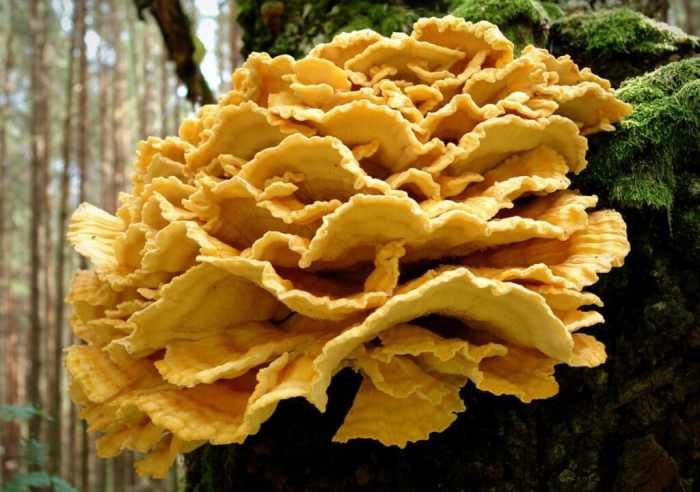
Identifying and foraging for chicken of the woods mushrooms is a rewarding experience, but it requires caution and knowledge to ensure safety. These mushrooms have distinct characteristics that help distinguish them from other species, and it’s crucial to adhere to responsible foraging practices to preserve the environment and avoid any adverse effects.
Another great way to cook chicken of the woods is to use it in a soup or stew. The mushrooms will add a rich flavor and texture to the dish. For a hearty and flavorful soup, try this chicken of the woods recipe . This recipe uses a variety of vegetables and spices to create a delicious and nutritious soup.
Distinguishing Characteristics
Chicken of the woods mushrooms are typically found growing on dead or decaying hardwood trees, especially oaks. They appear as bright orange or yellow shelf-like structures with a wavy or lobed shape. The upper surface is velvety and often fades to a paler color towards the edges, while the underside is covered in small pores.
The flesh is white, firm, and has a mild, slightly fruity aroma.
Responsible Foraging
When foraging for chicken of the woods mushrooms, it’s essential to follow ethical practices to ensure the sustainability of the species and the health of the ecosystem. Here are some key guidelines:
- Only harvest mushrooms that you can confidently identify as chicken of the woods.
- Avoid collecting mushrooms from areas that have been treated with pesticides or herbicides.
- Cut the mushrooms cleanly at the base of the stem to avoid damaging the mycelium.
- Leave some mushrooms behind for spore production and the continuation of the species.
- Respect the environment and avoid disturbing the surrounding vegetation or wildlife.
Culinary Applications
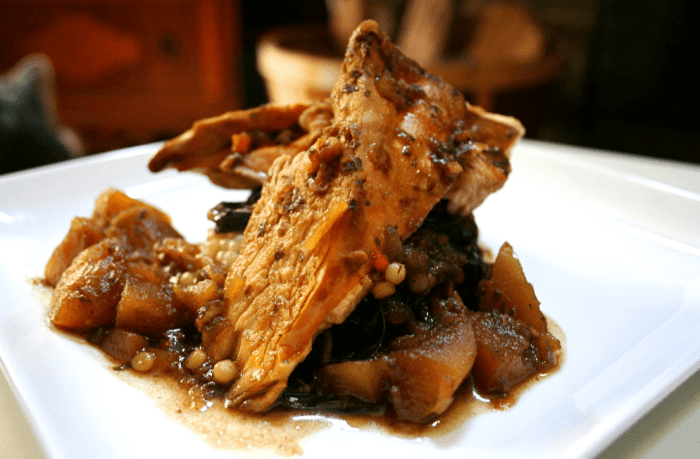
Chicken of the woods mushrooms are a versatile culinary ingredient that can be enjoyed in a variety of dishes. Their meaty texture and mild flavor make them a great substitute for chicken in many recipes.
These mushrooms can be cooked using a variety of methods, including sautéing, roasting, and grilling. Sautéing is a quick and easy way to cook chicken of the woods mushrooms, and it results in a tender and flavorful dish. Roasting is another great option, as it brings out the mushrooms’ earthy flavor.
Grilling is a great way to cook chicken of the woods mushrooms if you’re looking for a smoky flavor.
Pairing with other ingredients
Chicken of the woods mushrooms have a mild flavor that pairs well with a variety of other ingredients. They can be used in soups, stews, casseroles, and stir-fries. They can also be used as a topping for pizzas and pasta dishes.
Chicken of the woods mushrooms are also a great addition to salads and sandwiches.
Substitutions and Alternatives
When chicken of the woods mushrooms are not available, several alternatives can be used to replicate their unique flavor and texture in recipes. These substitutes offer similar culinary applications and nutritional benefits, making them suitable replacements.
Oyster Mushrooms
- Similarities: Oyster mushrooms possess a meaty texture and mild, earthy flavor that closely resemble chicken of the woods.
- Differences: Oyster mushrooms are smaller and have a more delicate texture than chicken of the woods.
- Recipe Adjustments: When substituting oyster mushrooms, use a slightly larger quantity to compensate for their smaller size.
Maitake Mushrooms
- Similarities: Maitake mushrooms have a dense, meaty texture and a slightly nutty flavor that complements many dishes.
- Differences: Maitake mushrooms are more expensive than chicken of the woods and have a more pronounced flavor.
- Recipe Adjustments: Reduce the quantity of maitake mushrooms used in recipes by about half to avoid overpowering the dish.
Shiitake Mushrooms
- Similarities: Shiitake mushrooms have a firm texture and a rich, savory flavor that can add depth to various dishes.
- Differences: Shiitake mushrooms have a more intense flavor than chicken of the woods and can be slightly chewy.
- Recipe Adjustments: Soak shiitake mushrooms in warm water for 20 minutes before using to soften their texture and reduce their strong flavor.
Preservation Techniques
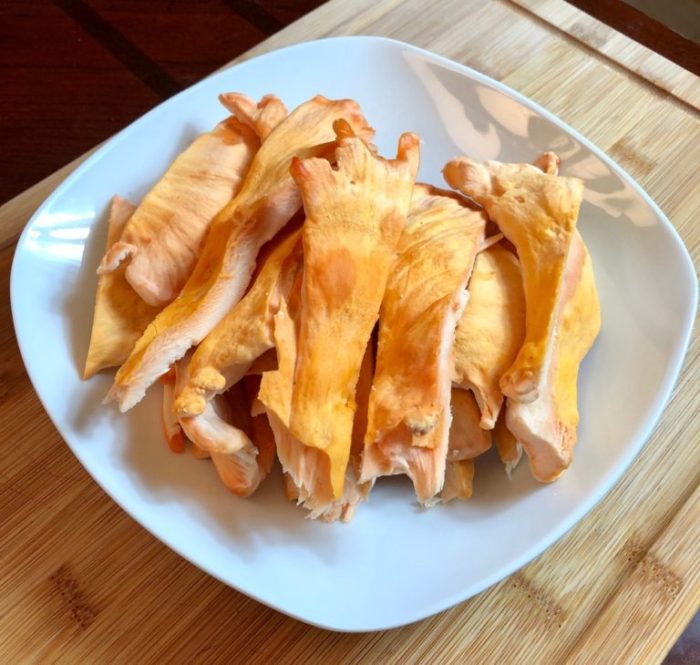
Chicken of the woods mushrooms can be preserved using various methods, each with its own benefits and drawbacks. Understanding these techniques is crucial for maintaining the flavor and nutritional value of these mushrooms over extended periods.
Drying, Chicken of the woods recipe
Drying is an effective method for preserving chicken of the woods mushrooms. Dehydration removes moisture, inhibiting microbial growth and extending the shelf life of the mushrooms. Sliced mushrooms can be air-dried in a warm, well-ventilated area or using a food dehydrator.
Once completely dry, they can be stored in airtight containers at room temperature for several months. Dried mushrooms can be rehydrated by soaking them in warm water before use.
Freezing
Freezing is another option for preserving chicken of the woods mushrooms. Blanching the mushrooms before freezing helps retain their texture and flavor. To blanch, briefly boil the mushrooms and then immediately transfer them to an ice bath. Once cooled, drain the mushrooms thoroughly and place them in freezer-safe bags or containers.
Chicken of the woods is a type of mushroom that can be found in forests throughout the world. It’s a popular edible mushroom that has a meaty texture and a slightly sweet flavor. If you’re looking for a delicious and easy way to cook chicken of the woods, check out this chicken of the woods recipe . This recipe is simple to follow and will result in a flavorful and satisfying dish.
Frozen mushrooms can be stored for up to 6 months. When ready to use, thaw the mushrooms in the refrigerator or at room temperature.
Canning
Canning is a more involved method of preserving chicken of the woods mushrooms, but it allows for long-term storage. The mushrooms should be cleaned, sliced, and blanched before being packed into jars. A brine or vinegar solution is then added to the jars, and they are sealed and processed in a boiling water bath or pressure canner.
Canned mushrooms can be stored in a cool, dark place for up to a year.
Additional Tips for Preservation
* Choose fresh, firm mushrooms for preservation.
- Clean the mushrooms thoroughly before drying, freezing, or canning.
- Store preserved mushrooms in a cool, dry place away from direct sunlight.
- Dried mushrooms should be stored in airtight containers to prevent moisture absorption.
- Frozen mushrooms should be thawed slowly to avoid damaging their texture.
- Canned mushrooms should be refrigerated after opening.
By following these preservation techniques, you can enjoy the delicious flavor and nutritional benefits of chicken of the woods mushrooms throughout the year.
Ultimate Conclusion
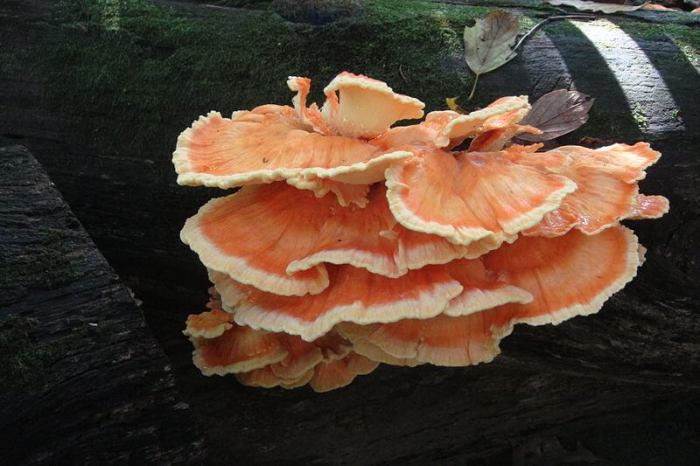
Chicken of the woods is a versatile ingredient that can elevate any dish with its unique flavor and nutritional benefits. Whether you’re a seasoned chef or a novice cook, we encourage you to experiment with this culinary treasure. From savory stir-fries to hearty soups and flavorful pasta dishes, the possibilities are endless.
So, venture into the woods, embrace the joy of foraging, and let the chicken of the woods inspire your culinary creations.
Key Questions Answered
What are the health benefits of chicken of the woods?
Chicken of the woods is rich in antioxidants, which help protect cells from damage. It also contains beta-glucans, which have immune-boosting properties. Additionally, some studies suggest that it may have anti-cancer effects.
How can I identify chicken of the woods?
Chicken of the woods is characterized by its bright orange color and shelf-like shape. It typically grows on dead or dying hardwood trees, especially oaks. The flesh is white and firm, with a slightly sour taste when raw.
How do I cook chicken of the woods?
Chicken of the woods can be cooked in a variety of ways, including sautéing, roasting, and grilling. It can be used as a meat substitute in soups, stews, and pasta dishes. It also makes a delicious addition to salads and sandwiches.





